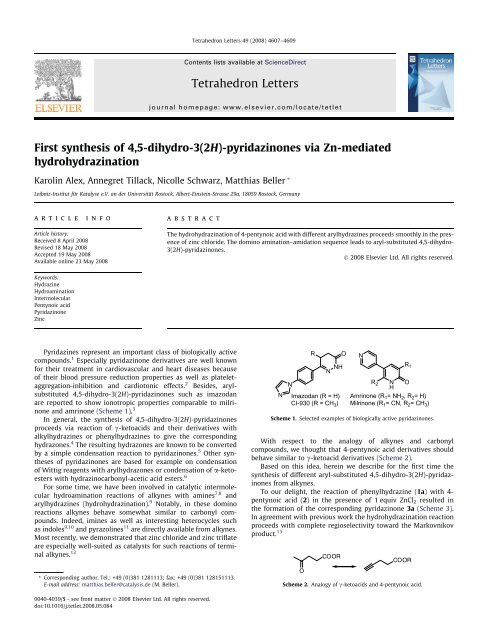synthesis and catalytic functionalization of biologically active indoles
synthesis and catalytic functionalization of biologically active indoles
synthesis and catalytic functionalization of biologically active indoles
Create successful ePaper yourself
Turn your PDF publications into a flip-book with our unique Google optimized e-Paper software.
First <strong>synthesis</strong> <strong>of</strong> 4,5-dihydro-3(2H)-pyridazinones via Zn-mediated<br />
hydrohydrazination<br />
Karolin Alex, Annegret Tillack, Nicolle Schwarz, Matthias Beller *<br />
Leibniz-Institut für Katalyse e.V. an der Universität Rostock, Albert-Einstein-Strasse 29a, 18059 Rostock, Germany<br />
article info<br />
Article history:<br />
Received 8 April 2008<br />
Revised 18 May 2008<br />
Accepted 19 May 2008<br />
Available online 23 May 2008<br />
Keywords:<br />
Hydrazine<br />
Hydroamination<br />
Intermolecular<br />
Pentynoic acid<br />
Pyridazinone<br />
Zinc<br />
abstract<br />
Pyridazines represent an important class <strong>of</strong> <strong>biologically</strong> <strong>active</strong><br />
compounds. 1 Especially pyridazinone derivatives are well known<br />
for their treatment in cardiovascular <strong>and</strong> heart diseases because<br />
<strong>of</strong> their blood pressure reduction properties as well as plateletaggregation-inhibition<br />
<strong>and</strong> cardiotonic effects. 2 Besides, arylsubstituted<br />
4,5-dihydro-3(2H)-pyridazinones such as imazodan<br />
are reported to show ionotropic properties comparable to milrinone<br />
<strong>and</strong> amrinone (Scheme 1). 3<br />
In general, the <strong>synthesis</strong> <strong>of</strong> 4,5-dihydro-3(2H)-pyridazinones<br />
proceeds via reaction <strong>of</strong> c-ketoacids <strong>and</strong> their derivatives with<br />
alkylhydrazines or phenylhydrazines to give the corresponding<br />
hydrazones. 4 The resulting hydrazones are known to be converted<br />
by a simple condensation reaction to pyridazinones. 5 Other syntheses<br />
<strong>of</strong> pyridazinones are based for example on condensation<br />
<strong>of</strong> Wittig reagents with arylhydrazones or condensation <strong>of</strong> a-ketoesters<br />
with hydrazinocarbonyl-acetic acid esters. 6<br />
For some time, we have been involved in <strong>catalytic</strong> intermolecular<br />
hydroamination reactions <strong>of</strong> alkynes with amines 7,8 <strong>and</strong><br />
arylhydrazines (hydrohydrazination). 9 Notably, in these domino<br />
reactions alkynes behave somewhat similar to carbonyl compounds.<br />
Indeed, imines as well as interesting heterocycles such<br />
as <strong>indoles</strong> 9,10 <strong>and</strong> pyrazolines 11 are directly available from alkynes.<br />
Most recently, we demonstrated that zinc chloride <strong>and</strong> zinc triflate<br />
are especially well-suited as catalysts for such reactions <strong>of</strong> terminal<br />
alkynes. 12<br />
* Corresponding author. Tel.: +49 (0)381 1281113; fax: +49 (0)381 128151113.<br />
E-mail address: matthias.beller@catalysis.de (M. Beller).<br />
0040-4039/$ - see front matter Ó 2008 Elsevier Ltd. All rights reserved.<br />
doi:10.1016/j.tetlet.2008.05.084<br />
Tetrahedron Letters 49 (2008) 4607–4609<br />
Contents lists available at ScienceDirect<br />
Tetrahedron Letters<br />
journal homepage: www.elsevier.com/locate/tetlet<br />
The hydrohydrazination <strong>of</strong> 4-pentynoic acid with different arylhydrazines proceeds smoothly in the presence<br />
<strong>of</strong> zinc chloride. The domino amination–amidation sequence leads to aryl-substituted 4,5-dihydro-<br />
3(2H)-pyridazinones.<br />
Ó 2008 Elsevier Ltd. All rights reserved.<br />
N<br />
N<br />
R<br />
N NH<br />
Imazodan (R = H)<br />
CI-930 (R = CH 3)<br />
O<br />
With respect to the analogy <strong>of</strong> alkynes <strong>and</strong> carbonyl<br />
compounds, we thought that 4-pentynoic acid derivatives should<br />
behave similar to c-ketoacid derivatives (Scheme 2).<br />
Based on this idea, herein we describe for the first time the<br />
<strong>synthesis</strong> <strong>of</strong> different aryl-substituted 4,5-dihydro-3(2H)-pyridazinones<br />
from alkynes.<br />
To our delight, the reaction <strong>of</strong> phenylhydrazine (1a) with 4pentynoic<br />
acid (2) in the presence <strong>of</strong> 1 equiv ZnCl 2 resulted in<br />
the formation <strong>of</strong> the corresponding pyridazinone 3a (Scheme 3).<br />
In agreement with previous work the hydrohydrazination reaction<br />
proceeds with complete regioselectivity toward the Markovnikov<br />
product. 13<br />
N<br />
R 1<br />
R2 N O<br />
H<br />
Amrinone (R1= NH2, R2= H)<br />
Milrinone (R1= CN, R2= CH3) Scheme 1. Selected examples <strong>of</strong> <strong>biologically</strong> <strong>active</strong> pyridazinones.<br />
O<br />
COOR<br />
COOR<br />
Scheme 2. Analogy <strong>of</strong> c-ketoacids <strong>and</strong> 4-pentynoic acid.

















